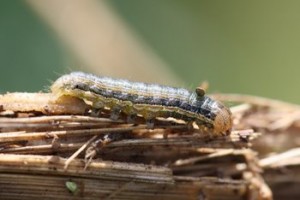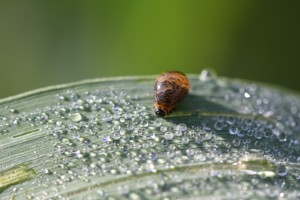I’ve had several questions this week about whether an insecticide should be included when spraying a fungicide when spraying wheat. My general response to questions like this is “no”. It is the same question I frequently get in soybean and the same answer. It is like asking me if you should spray for plant bugs at first bloom. If there are pest present at threatening (threshold) level, then we should definitely take advantage of piggy-back applications. I often recommend preventative insecticides in high risk/reward scenarios. The use of seed treatments in cotton is a good example. Another example is my recommendation to spray low populations of aphid in wheat during late winter for the prevention of barely yellow dwarf virus. However, throwing an insecticide in the tank “just because” is not responsible. It adds unnecessary cost and does not promote the reputation of farmers as being good stewards of the environment.
Enough of the soapbox! There are a couple of pests to keep an eye out, namely true armyworms and cereal leaf beetles. I’ve heard only rumors of infestations this year, but you should scout for these pests regularly and especially before making a fungicide application. Treatment thresholds and insecticide options are available on UTcrops.com at Insect Control Recommendations for Wheat.

True Armyworm. This caterpillar may cause yield loss if excessive defoliation occurs during or before the milk stage. UT recommends treating for armyworms when 6-8 larvae are present per square foot and wheat is in the milk stage (or less mature). Pyrethroid insecticides are most commonly used and are effective. Labeled pyrethroids include Baythroid XL, Declare, Karate/Warrior, Mustang Max (among others).

Cereal Leaf Beetle. The adults and larvae of this insect may occasionally cause premature defoliation, but it is larvae that really cause almost all of the defoliation. The beetle larvae cover themselves with their own gooey feces. It is usually pretty obvious when you have many because they stain your pants when you walk through the field. Treatment is recommended when 25 or more larvae are present per 100 tillers. The pyrethroids listed above are also effective at controlling this pest.


Subject change: Please discuss early season TPB management. We are mowing the field borders and waterways now where 2013 cotton will be planted. My driver said insects are in a “cloud” around his tractor in places. Why may we not also spray these areas to eliminate this generation of TPB? If we had access to a sprayer that the BWEP used to spray field boundaries, fence-rows, tree-lines, etc for boll weevils wouldn’t that be helpful in knocking back TPB, too?
Thanks for the question. I think what you are doing is the best that can be done. Since cotton is nowhere near the susceptible stage, flushing plant bugs out will cause no immediate harm. Mowing will reduce the attractiveness of the flowering weeds and cause some mortality of nymphs developing on these plants. Unfortunately, one mowing is not usually enough to have full effect. You have to be careful mowing flowering weeds that are holding plant bugs if susceptible cotton is nearby. I know of no insecticides labeled for the uses you are describing. Besides being an illegal application, there is some downside in you would be selecting for resistant plant bugs even before the season starts. I know of folks that have used mist sprayers for what you have described, but this is not a recommended practice. We’ve experimented spraying herbicides (i.e., Strike 3) which kills broadleaves (good plant bug hosts) and leaves grasses (poor hosts). It can work but is difficult in small fields where borders become a bigger part of the land area. You still have to read and follow the label when applying these herbicides, and it is too late for this. These applications are risky when crops are already planted.
At exactly what growth stage is “susceptible cotton” present?
Anytime between first square and NAWF5 + 250 DD60s